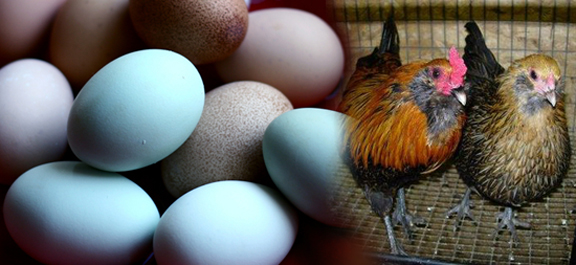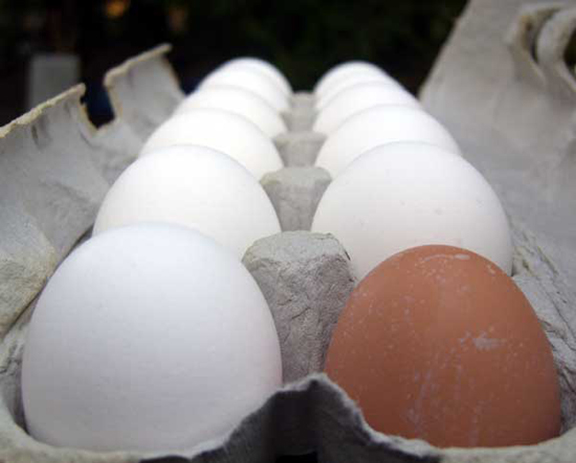<BACK VOTE FOR THE WATERPOD™ CHICKEN
Waterpod™is an accessible self-reliant eco-habitat, exhibition and living space, constructed with the advancing sea levels in mind. It is a showcase for sustainable attainable grassroots technology and will become an available open source manual of creative solutions and a platform for dialogue, but it is also an exhibition center for contemporary art and an art installation in and of itself. We need to choose what kind of chickens we are going to have on the pod, and you can help us decide. If Waterpod™ were a chicken, what kind of chicken would she be?
JUST CLICK BELOW TO SEND US AN EMAIL WITH YOUR CHOICE >>

-Left to Right: Eggs, including blue Ameraucana eggs, and an Ameraucana rooster and hen.
1. Novel, artistic, unusual, and lovely to live with >> click above image to vote
Ameraucana, Araucana, Rumpless Araucana or Easter Eggers
The Araucana and Rumpless Araucana were introduced from Chile in 1921, from one of several different blue egg-laying chicken breeds. In pre-Columbian Chile, there were several different blue egg-laying chicken breeds, none called Araucana. It is likely that some "mongrelization" occurred before standardization. The Araucana as we know it today is a hybrid of two South American breeds: the Collonca (a naturally blue-egg laying, rumpless, clean-faced chicken) and the Quetros (a pinkish-brown egg layer that is tailed and has ear-tufts). The truest bred carry a "lethal gene" which is also connected to their tufting characteristic, though standards differ internationally. They are well adaptable to confinement or free range, are naturally calm and non-aggressive. They lay blue eggs only . There has long been debate whether araucanas were bred from chickens brought by Europeans to South America after Columbus or rather arose from chickens brought directly over the Pacific Ocean from someplace nearer to all chickens' presumed ancestral home in Southeast Asia. If araucanas predate the Europeans in South America, their presence implies pre-Columbian trans-Pacific contacts between Asia and South America. The Ameraucana may or may not be genetically related to the Araucana. The Ameraucana breed became standardized and accepted into the American Poultry Association in 1984. They tend to be well adapted to confinement or free range and are mostly calm and non-aggressive. They lay medium sized eggs in various shades of blue and blue-green. Like the Araucana and Rumpless Araucana, Ameraucana are good brooders and very cold hardy. Most hatcheries, however, sell Easter Egg chickens with mixed breeding that may lay blue, green (or other colored) eggs, but do not conform to standard. The personality of mongrel Easter Eggers is widely varied, some are aloof, while others are very friendly and easily handled.

-Left to Right: Leghorn, Rhode Island Red.
2. Classic, economical, efficient, and can foretell the future >> click above image to vote
The Leghorn and the Rhode Island Red
The Leghorn is renowned as the ultimate egg machine. It is an ancient breed, which was greatly developed in the 19th and 20th centuries. The Leghorn was honored by the ancient Romans, and the white variety was reportedly developed for use in ceremony for foretelling the future. It remains one of the most popular birds on the planet. It is an economical eater, and better adapted to confinement then some Mediterranean breeds. It is a flyer that enjoys free range. It is flighty, spritely, noisy, nervous, and usually avoids human contact. It is hardy and heat tolerant. The Leghorn lays medium to large pearl colored eggs. Due to their prolific egg-laying, they are preferred by laboratories for embryonic and avian biological research as well as being the number one breed used for large-scale commercial egg production in the United States. The Rhode Island Red is a hardy robust breed well adapted to confinement or free range developed in New England in the 19th century. They are known as the best of all chicken breeds for producing brown eggs. The Rhode Island Red is active, calm and fairly docile, though it can be aggressive. The cocks are especially notorious for aggressiveness. They are a popular choice for backyard flocks because of their egg laying abilities and hardiness. They lay large, rich brown eggs and are heat tolerant.
Why are Chicken Eggs Different Colors?
wisegeek.com
Chicken eggs from various chicken breeds emerge in different shades because of pigments which are deposited as the eggs move through the hen's oviduct. The pigment depositions are determined by the chicken's genetics, with some breeds producing rich dark brown eggs, for example, while others lay snow white eggs. The eggs inside are essentially identical; there are no major flavor differences between chicken eggs from different birds, as the flavor is determined by the chicken's diet.
There are three main colors for chicken eggs. Most eggs in the store come in white or shades of brown. It is also possible to find blue to green chicken eggs, which come from the Aracuana, a breed of chicken developed in Chile. Araucanas have also been crossed with other breeds to produce the Americauna, sometimes called the “Easter egg chicken” in a reference to its multicolored eggs.
Originally, all chicken eggs were probably brown. Over time, people selectively bred chickens with progressively lighter eggs, ultimately producing white chicken eggs, which came to be the norm. Brown eggs were reintroduced to the market in the late 20th century, although people on farms were already quite familiar with the them. Some classic white egg laying breeds include Andalusians, Faverolles, Dorkings, Leghorns, and Lakenvelders. Barnevelders, Rhode Island Reds, Jersey Giants, Delawares, and Orpingtons are well known for their brown eggs, which vary in color from light cream to dark brown.
In many cases, a chicken with white ear lobes will produce white eggs, while chickens with red ear lobes lay brown eggs, although this is not always true. Size is not a determining factor, with white eggs coming from tiny Bantams just as they do from large Leghorns. The color of the chicken is also irrelevant; chickens actually come in a wide range of shapes, colors, and sizes which run the gamut from strange-looking Frizzled Cochins to sleek black and white Lakenvelders.
The color of chicken eggs should not influence your purchasing decisions at the market, as the contents of the egg are what counts. Chickens who eat free range, varied diets tend to produce healthier eggs, as their free range lifestyles allow them to consume the dietary minerals they need for their own health, and these minerals will be passed down in their eggs. You may also have noticed that farm-fresh eggs have very dark yolks, whereas chicken eggs from battery hens have much lighter yolks, indicating less nutritional value.





